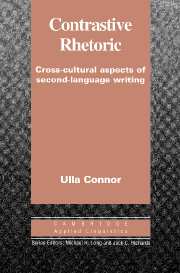Book contents
- Frontmatter
- Contents
- Series editors' preface
- Preface
- I PRELIMINARIES; EARLY PHASES OF THE FIELD
- 1 Toward an extended definition of contrastive rhetoric
- 2 Contrastive rhetoric studies in applied linguistics
- 3 Historical evolution of contrastive rhetoric: from Kaplan's 1966 study to diversification in languages, genres, and authors
- II INTERFACES WITH OTHER DISCIPLINES
- III IMPLICATIONS OF CONTRASTIVE RHETORIC
- References
- Author index
- Subject index
3 - Historical evolution of contrastive rhetoric: from Kaplan's 1966 study to diversification in languages, genres, and authors
Published online by Cambridge University Press: 05 October 2012
- Frontmatter
- Contents
- Series editors' preface
- Preface
- I PRELIMINARIES; EARLY PHASES OF THE FIELD
- 1 Toward an extended definition of contrastive rhetoric
- 2 Contrastive rhetoric studies in applied linguistics
- 3 Historical evolution of contrastive rhetoric: from Kaplan's 1966 study to diversification in languages, genres, and authors
- II INTERFACES WITH OTHER DISCIPLINES
- III IMPLICATIONS OF CONTRASTIVE RHETORIC
- References
- Author index
- Subject index
Summary
This chapter has five sections. The first section begins with a discussion of the theory of linguistic relativity, the cornerstone of contrastive rhetoric, and then reviews Kaplan's seminal works on contrastive rhetoric – an article (1966) and a book (1972). The next four sections provide reviews of contrastive rhetorical research conducted by several other ESL researchers. These reviews provide the reader with references to the most significant research. The research is categorized by the first language of the ESL students whose writing was studied: Arabic, Chinese, Japanese, Korean, German, Finnish, Spanish, and Czech.
Origins of contrastive rhetoric
The theory of linguistic relativity
The Sapir-Whorf hypothesis of linguistic relativity, also called the Whorfian hypothesis, suggests that different languages affect perception and thought in different ways. Anthropologist Edward Sapir wrote:
It is highly important to realize that once the form of a language is established it can discover meanings for its speakers which are not simply traceable to the given quality of experience itself but must be explained to a large extent as the projection of potential meaning into the raw material of experience.
Language is heuristic, not merely in the simple sense which this example suggests, but in the much more far-reaching sense that its forms predetermine for us certain modes of observation and interpretation. (Mandelbaum, 1951)
Benjamin Whorf, a student of Sapir's, elaborated on the ideas of Sapir, as the following quotation shows: This study shows that the forms of a person's thoughts are controlled by inexorable laws of patterns of which he is unconscious.
- Type
- Chapter
- Information
- Contrastive RhetoricCross-Cultural Aspects of Second Language Writing, pp. 28 - 56Publisher: Cambridge University PressPrint publication year: 1996



